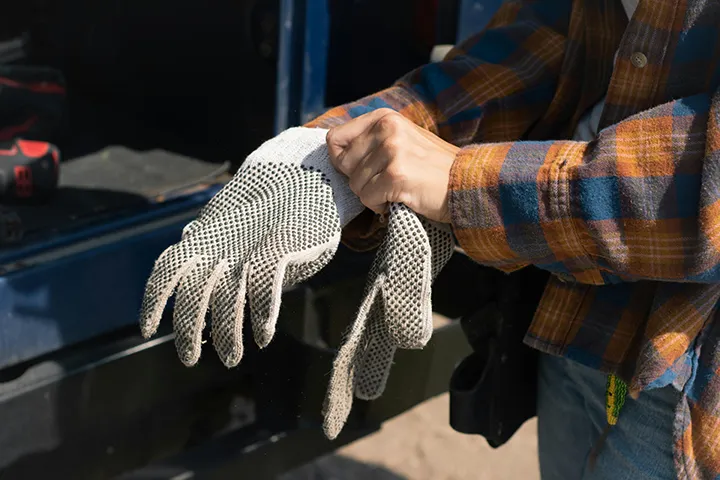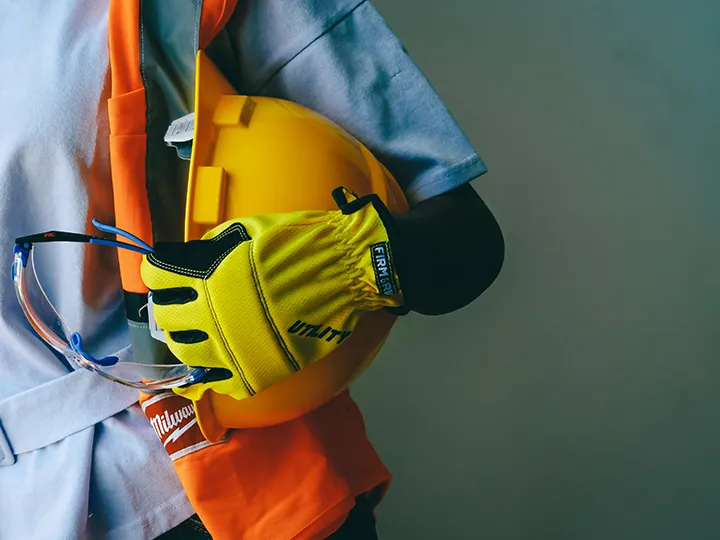As the cool air moves in and the days grow shorter, construction sites across Ontario come alive with urgency. Fall is the season when many contractors ramp up production—pouring concrete, closing roofs, finishing exterior work, and preparing sites for the long winter ahead.
But as work intensifies, safety must remain a non-negotiable priority. The change in weather, reduced daylight, and compressed timelines all increase the potential for incidents and injuries.
At Safety Training and Consulting Services Ltd. (STC), we’ve seen firsthand that companies that plan ahead, train effectively, and follow strong construction safety policies and procedures perform better—both in productivity and in worker well-being.
This blog explores the most common fall hazards, prevention strategies, and how professional training and safety planning can protect workers during one of the busiest times of the year.
Why Fall Is a High-Risk Season in Construction
The fall construction season brings unique challenges that can catch even experienced teams off guard.
1. Schedule Pressure
Many Ontario contractors race to finish projects before winter freezes or heavy snow set in. This can lead to fatigue, skipped steps, or rushing critical tasks like trenching, roofing, or concrete finishing.
2. Unpredictable Weather
Cool mornings, warm afternoons, and damp evenings mean slippery conditions, reduced visibility, and shifting ground stability. A surface that’s dry in the morning might be icy by dusk.
3. Shorter Daylight Hours
With darkness arriving earlier, visibility on construction sites becomes a major safety concern. Poor lighting increases the risk of slips, trips, falls, and vehicle collisions.
4. Trade Overlap
As multiple trades converge near project completion—framers, roofers, electricians, masons, and landscapers—the site becomes more congested, increasing the chance of unsafe interactions and miscommunication.
5. Worker Fatigue
Longer hours and cooler weather can lead to both mental and physical fatigue. Tired workers make slower decisions, take shortcuts, and are more likely to suffer injuries.
Common Fall Construction Safety Hazards

The changing season introduces several high-priority hazards every employer should address:
Slips, Trips, and Falls
Fallen leaves, rain, frost, and mud make surfaces slick. Walkways, scaffold decks, and stairs must be kept clean, dry, and well-lit.
Prevention tips:
- Sweep or blow leaves from walk paths and work areas daily.
- Apply grit or sand to icy or wet areas.
- Use anti-slip mats and proper drainage.
- Encourage good housekeeping habits at every level of the crew.
Work at Heights
Wind, rain, and cold temperatures can affect both worker stability and equipment performance.
Best practices:
- Inspect fall arrest systems daily.
- Secure materials that could shift or blow off elevated areas.
- Avoid working at heights in gusting wind conditions.
- Conduct regular rescue drills and ensure all harnesses, anchors, and lanyards are certified.
Reduced Visibility and Lighting
Short days mean more work occurs during early mornings or late afternoons.
Solutions:
- Install temporary lighting for dim areas.
- Use high-visibility vests, cones, and reflective tape.
- Position lighting to avoid glare or shadows.
- Mark hazards and vehicle routes clearly.
Equipment Operation and Ground Conditions
As the ground softens due to rain, equipment stability can decrease, and trench walls can become unstable.
Safety reminders:
- Re-assess ground conditions daily.
- Don’t overload machinery on wet or uneven terrain.
- Inspect tires and tracks for traction.
- Maintain a minimum distance from trenches, edges, and slopes.
Cold Stress and Worker Comfort
Fall weather can fluctuate drastically. Workers might start the day in freezing temperatures and end it sweating.
Control measures:
- Provide heated break areas.
- Encourage proper layering of clothing.
- Train workers on the early signs of cold stress and hypothermia.
- Schedule warm-up breaks for prolonged outdoor work.
Material Storage and Securing
High winds are more common in the fall. Lightweight materials, tarps, and temporary structures can become airborne hazards.
Prevention tips:
- Tie down materials and cover supplies securely.
- Inspect scaffolds and barriers after every high-wind event.
- Avoid storing lightweight materials at height.
The Importance of Training and Competency
No matter how solid your written procedures are, the success of your safety program depends on worker knowledge and consistent behaviour.
At STC, we emphasize that effective training is the backbone of a safe job site—especially in high-pressure seasons like fall.
Core Training Priorities for the Fall Construction Season
- Working at Heights – refresher or certification training to ensure fall arrest system competency.
- Slips, Trips, and Falls Prevention – hazard identification, footwear selection, and site housekeeping techniques.
- Equipment and Operator Training – forklift, skid steer, elevated work platform, and telehandler safety.
- Supervisor Due Diligence – ensuring competent supervision, incident response, and communication.
- WHMIS / Chemical Handling – for sites using antifreeze, de-icing agents, or winter preparation products.
- Personal Protective Equipment (PPE) – inspection, maintenance, and replacement of cold-weather PPE.
- Emergency and Rescue Preparedness – drills for falls, cold stress, or vehicle incidents.
Why Refresher Training Matters
Competency is not permanent. Seasonal refreshers keep knowledge current and ensure that safe habits are practiced—not assumed.
Regular refresher training:
- Reinforces awareness of seasonal hazards
- Helps new or temporary workers integrate quickly
- Keeps employers compliant with Ontario’s Occupational Health and Safety Act (OHSA)
- Reduces risk of costly downtime, fines, or injuries
Policies and Procedures: Your Roadmap to a Safer Season
Written policies and procedures aren’t just administrative paperwork—they’re the operational map for safe work.
A strong health and safety management system should include:
1. A Clear Health and Safety Policy
This outlines leadership’s commitment to maintaining a safe workplace and sets expectations for all levels of staff.
2. Safe Work Practices and Procedures
These documents describe exactly how to perform tasks safely. For fall construction, review and update procedures for:
- Scaffold use and inspections
- Roofing and edge protection
- Temporary lighting installation
- Snow or ice removal on work surfaces
- Material storage and equipment parking
3. Inspection and Maintenance Programs
Frequent site inspections are essential during the fall season. A proactive inspection system identifies hazards before incidents occur.
4. Incident and Near-Miss Reporting
Encourage open reporting and quick corrective actions. Every near-miss is an opportunity to prevent a serious injury later.
5. Communication and Worker Engagement
Safety thrives when workers are involved. Host toolbox talks that focus on seasonal hazards, encourage feedback, and celebrate proactive safety behaviour.
Management’s Role in Fall Safety
Leadership commitment drives workplace culture. When managers prioritize safety, workers follow suit.
Key management responsibilities during the fall season include:
- Conducting safety walkthroughs and observations
- Reinforcing stop-work authority for unsafe conditions
- Monitoring workload and fatigue levels
- Recognizing safe work performance
- Ensuring supervisors are trained and empowered to act
Good leadership means balancing production goals with safety accountability—because meeting a deadline is never worth risking a worker’s well-being.
How Documentation and Recordkeeping Support Compliance
Good recordkeeping is essential. Safety documentation provides evidence of due diligence, supports compliance with Ministry of Labour, Immigration, Training and Skills Development (MLITSD) inspections, and protects your organization in case of incidents.
Keep accurate records of:
- Training certifications and expiry dates
- Workplace inspections
- Equipment maintenance logs
- Toolbox talks and safety meetings
- Incident and corrective action reports
Digital tools make this process more efficient, but even simple checklists can go a long way in maintaining order and compliance.
Engaging Workers: The Heart of Fall Safety
Your best line of defense against workplace injuries is an engaged, informed team. Workers who understand the “why” behind safety requirements are more likely to follow them.
Encourage worker participation by:
- Asking for input during pre-job hazard assessments
- Recognizing individuals who report hazards or near misses
- Offering feedback sessions after training or incidents
- Sharing success stories where safe actions prevented harm
Engagement transforms safety from a rulebook into a shared value.
Fall Construction Safety Checklist

Before you ramp up for the final quarter, review this Fall Safety Checklist:
✅ Conduct a seasonal hazard assessment
✅ Deliver refresher safety training to all staff and supervisors
✅ Inspect ladders, scaffolds, and fall protection equipment
✅ Verify lighting adequacy for reduced daylight
✅ Update emergency response and rescue plans
✅ Secure all materials and temporary structures
✅ Review and document worker competency
✅ Schedule regular site inspections and toolbox talks
✅ Communicate daily about changing weather conditions
✅ Keep all records current and easily accessible
Safety, Productivity, and Reputation Go Hand in Hand
There’s a common misconception that prioritizing safety slows production—but experience proves the opposite. Companies with strong safety programs:
- Have fewer delays and work stoppages
- Experience lower WSIB claims and insurance premiums
- Maintain better employee morale and retention
- Earn reputations as reliable, professional contractors
Simply put: safe sites stay productive.
How STC Helps Construction Companies Stay Safe This Fall
Safety Training and Consulting Services Ltd. provides Ontario employers with practical, certified solutions for maintaining construction safety throughout the year—especially during high-risk seasons.
Our services include:
- Customized Health and Safety Policies and Procedures
- Workplace Inspections and Hazard Assessments
- Competency-Based Training (including Working at Heights, Supervisor Competency, and PPE)
- Emergency Preparedness Programs
- Mock Audits and documentation reviews
- Leadership coaching for safety culture development
We also help construction companies prepare for compliance audits and recognition programs such as COR® and COR2020, ensuring their policies and practices meet the highest industry standards.
Final Thoughts: Don’t Rush, Work Smart
As fall construction ramps up across Ontario, remember this simple rule:
“Work fast enough to meet your goals—but slow enough to stay safe.”
Every site, every worker, and every season brings new challenges. But with planning, training, and strong leadership, safety doesn’t have to be compromised for progress.
At STC, we stand by our message:
“We care because life and your safety are worth it.”
This fall, take time to strengthen your safety systems, refresh training, and prepare your crews—not just for winter, but for long-term success.
Safety Training & Consulting Services Ltd. (STC)
Serving Ontario industries for over 15 years
CPO and TSSA Approved Training Provider | Construction • Healthcare • Industrial • Mining
